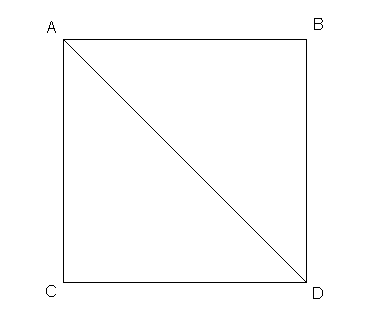

The proof is by contradiction. First assume that there does exist some rational number r that when squared is a prime number p. Then
r2 = p
By the definition of a rational number
r = a/b
where a and b are mutually prime integers. Then
pa2 = b2
implies that b2 is divisible by p. Therefore (by Euclid), b is divisible by p. That is,
b = ps
Where s is some integer. Substituting, we have
pa2 = p2s2
Dividing by p we have
a2 = ps2
Thus a is divisible by p, a contradiction (because a/b is irreducible). Therefore, our assumption that some irrational number squared is prime is false.
Suppose that p1/n, where n is an integer greater than 1, is rational. Then
p = an/bn
where a/b is an irreducible fraction and b > 1. Therefore an/bn is not an integer yet is equal to a prime, a contradiction.
Consider this figure of a unit square and its diagonal, AD:

The proof is by contradiction. Assume that the ratio of a side of the square to its diagonal is rational and is equal to n/m, where n and m are integers. By the Pythagorean theorem:
n2 = 2m2
This implies that n is even and m is odd. Let n = 2k. Then
4k2 = 2m2
We can simplify this to:
m2 = 2k2
which implies m is even, a contradiction. Therefore, length of the diagonal of a unit quare, equal to the square root of two, is irrational.
 Email: Richard dot J dot Wagner at gmail dot com
Email: Richard dot J dot Wagner at gmail dot com
Irrational.html; This hand crafted HTML file created December 7, 2001, by
Rick Wagner
last updated October 21, 2010, by Rick Wagner.
Copyright © 2001-2010 by Rick Wagner, all rights reserved.